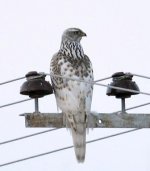My general knowledge of the different northern and eastern subsecies of the Goshawk was confirmed when after reading this thread I felt propelled to look deeper into the matter.
The information given in the IMO best bird book of the world, Handbook of the Birds of the World, neatly demonstrates the fact that there indeed is a
distinct colour morph of the subspecies albidus from Northeastern Siberia, which you could argue is leucistic of a sort (on the other hand we don't usually label pale males of Ruff in breeding plumage leucistic).
Pale/white morph is what I prefer to call this attractive Gos.
In the following link to a falconry forum I found what wasn't mentioned in H.B.B.W namely how often this white morph appears in the populations.
My gut feeling is that the following figures are correct (scroll down to the post from
SSL 17-04 2007 10.25 AM), but if anybody has a more thorough knowledge please chime in with corrections.
Interesting, and new to me, was the fact(?) that the Finnish/Russian/Siberian
buteoides population also has a white morph which makes up 5% of the birds.
Of the
albidus population of Notheastern Siberia the ratio of
white birds is a whopping 50%!
According to the info white birds in China are
migrating buteoides (juvenile Goshawks are of course much more prone to undertake longer migrations).
And white birds in Japan are migrating albidus.
That should make your bird a (scarce)
white morph of buteoides which makes sense in that it
doesn't at all look like the
white morph albidus depicted on plate 14 in HBBW and neither like any photos and carcasses I have seen from falconers of alledged albidus Goshawks.
Buteoides is of course highly interesting for birdwatchers in Scandinavia and northwestern Europe since juveniles are regularly seen in the winter season, and contrary to the largely sedentary adult birds
are identifiable in the field because of their variegated/mottled wingcoverts and secondaries with much whitish-cream in evidence.
What I'm getting at is the (remote) possibility to see one these stunning, ghostly white birds as far to the southwest as Denmark or neighbouring countries, although the 5% mentioned probably don't apply to the far western chunk of the buteoides population where 'our' vagrants come from.
Peter
www.falconryforum.co.uk/archive/index.php/t-27777.html







